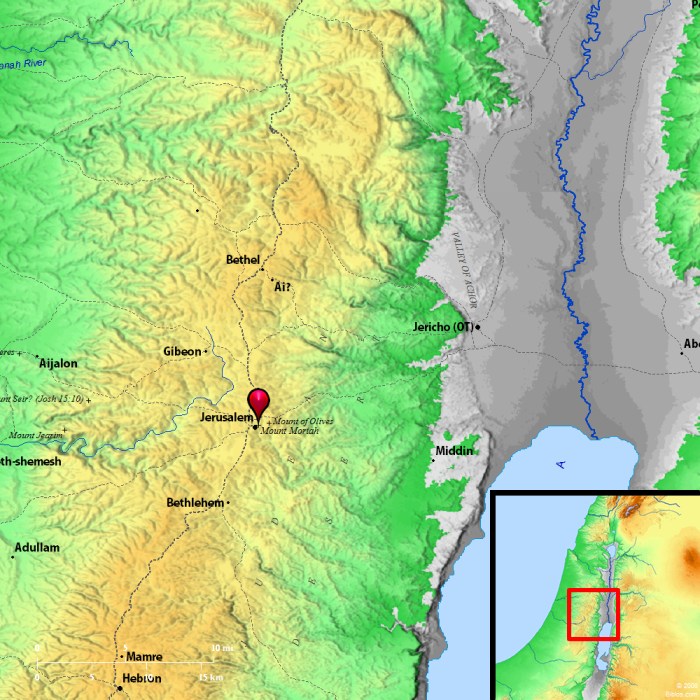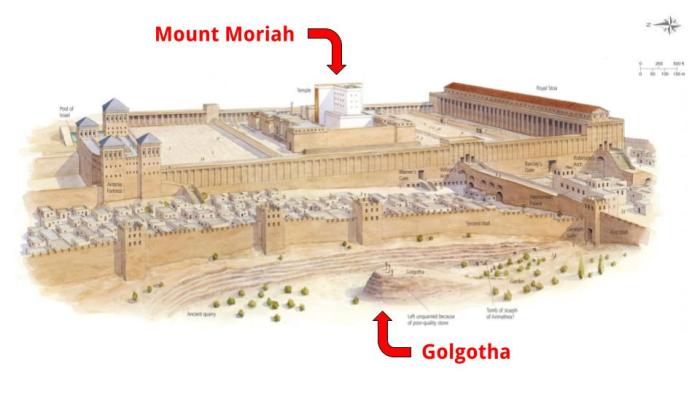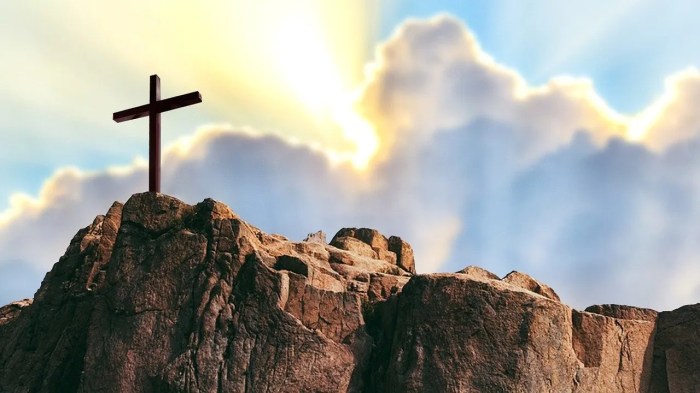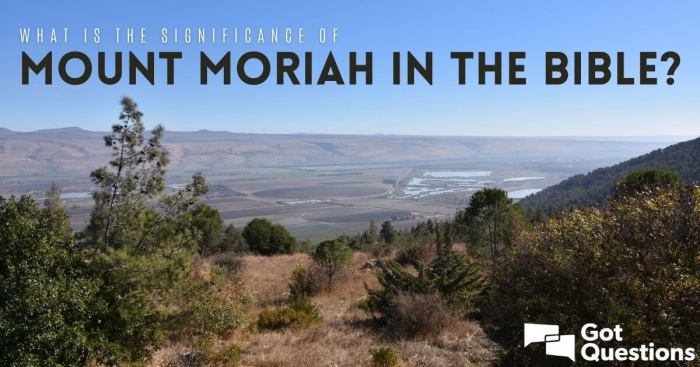Is Mount Moriah the Same as Calvary? This question has intrigued scholars and pilgrims for centuries. Both sites hold profound religious significance, but are they one and the same? This article delves into the historical, geographical, and theological connections between these two enigmatic locations, exploring the evidence and interpretations that have shaped our understanding of their relationship.
From the binding of Isaac to the crucifixion of Jesus, Mount Moriah and Calvary have been central to the unfolding drama of salvation history. Join us as we trace the threads that link these sacred places, unraveling the mysteries that surround their identities and the profound impact they have had on Christian faith and practice.
Mount Moriah and Calvary: Geographical and Historical Context

Mount Moriah and Calvary are two significant geographical locations in biblical history, each holding religious and historical importance.
Geographical Locations and Significance
Mount Moriah is a hill located in Jerusalem, believed to be the site where Abraham was tested by God to sacrifice his son Isaac. It is also the site of the Temple Mount, which houses the Dome of the Rock and the Al-Aqsa Mosque, sacred to both Jews and Muslims.
Calvary, also known as Golgotha, is a hill located outside the walls of ancient Jerusalem. It is believed to be the site where Jesus Christ was crucified. The name “Calvary” comes from the Latin word “calvaria,” meaning “skull,” referring to the shape of the hill.
Biblical Accounts
Mount Moriah is mentioned in the Book of Genesis as the place where Abraham was instructed by God to sacrifice his son Isaac. This event is seen as a test of Abraham’s faith and obedience to God.
Calvary is mentioned in the Gospels as the site of Jesus’ crucifixion. The crucifixion is a central event in Christianity, as it is believed to be the means by which Jesus atoned for the sins of humanity.
The Binding of Isaac and the Crucifixion: A Comparative Analysis: Is Mount Moriah The Same As Calvary

The stories of the binding of Isaac and the crucifixion of Jesus hold striking similarities and profound theological implications. Both narratives depict a father’s willingness to sacrifice his son and the son’s obedience to his father’s will.
Theologically, these events foreshadow the ultimate sacrifice of God’s own Son for the redemption of humanity. The binding of Isaac foreshadows God’s willingness to offer His Son as a sacrifice, while the crucifixion of Jesus represents the fulfillment of that sacrifice.
Symbolic Interpretations and Lessons Learned
- Obedience:Both Isaac and Jesus demonstrate unwavering obedience to their fathers, even when it involves great suffering.
- Faith:Abraham’s faith in God is tested through the binding of Isaac, while Jesus’ faith in His Father sustains Him through the crucifixion.
- Sacrifice:The binding of Isaac foreshadows the ultimate sacrifice of Jesus on the cross, demonstrating God’s love for humanity and His willingness to give His own Son for our redemption.
Temple Mount and Golgotha
Temple Mount and Golgotha hold immense religious significance in Judaism and Christianity. Temple Mount, located in Jerusalem, is the holiest site in Judaism, believed to be the location of the First and Second Temples. Golgotha, also known as Calvary, is the site where Jesus Christ is believed to have been crucified, making it a central location in Christian tradition.
Archaeological evidence and historical records provide insights into these sites. The Temple Mount has been extensively excavated, revealing remains of the Second Temple period and earlier structures. Golgotha, on the other hand, has been less extensively studied, but archaeological evidence suggests that it was a place of execution during the Roman period.
Religious Significance
For Jews, Temple Mount is the site of the Temple, which was the central place of worship and sacrifice. It is also believed to be the location of the binding of Isaac, a pivotal event in the Hebrew Bible. For Christians, Golgotha is the site of Jesus’ crucifixion, which is central to their faith and is commemorated during Holy Week.
Ongoing Debates
Despite the religious and historical significance of Temple Mount and Golgotha, there are ongoing debates and controversies surrounding their identification. Some scholars question the exact location of Golgotha, while others debate the historical accuracy of the biblical accounts associated with these sites.
The Identification of Calvary

The identification of Calvary, the site of Jesus’ crucifixion, has been a subject of debate and research for centuries. Various theories and interpretations have emerged, each supported by different lines of evidence and historical and archaeological factors.
Historical and Archaeological Factors
Historical accounts and archaeological excavations provide insights into the location of Calvary. The Gospel of John mentions that Jesus was crucified “outside the city gate” (John 19:20), which suggests a site near the city walls. Excavations in the Old City of Jerusalem have uncovered evidence of a first-century quarry, known as the “Gordon’s Tomb,” located just outside the Second Temple period city walls.
This site has been proposed as a potential location for Calvary.
Archaeological Evidence
Archaeological evidence also plays a role in identifying Calvary. In 1968, archaeologists discovered a first-century ossuary, or burial box, inscribed with the name “Yeshua bar Yosef,” which means “Jesus, son of Joseph.” This ossuary was found near the Gordon’s Tomb, adding further support to the theory that this site may have been Calvary.
Critical Analysis
The various theories and interpretations regarding the identification of Calvary have implications for our understanding of the historical context of Jesus’ crucifixion. The location of Calvary influences our understanding of the political and religious dynamics at play during that time.
While the evidence supporting each theory is compelling, it is important to critically evaluate the different perspectives and consider the limitations and strengths of each argument.
Ultimately, the identification of Calvary remains a matter of ongoing debate and research. The combination of historical accounts, archaeological evidence, and critical analysis continues to shape our understanding of this significant site in Christian history.
Mount Moriah and Calvary in Christian Tradition

The identification of Mount Moriah with Calvary has significantly influenced Christian beliefs and practices throughout history. In this section, we will trace the evolution of these beliefs and explore their impact on Christian theology, practices, and devotional traditions.
The Early Christian Era, Is mount moriah the same as calvary
The earliest Christian traditions associated Mount Moriah with Calvary. This connection is evident in the writings of the Church Fathers, such as Origen and Eusebius, who identified the Temple Mount as the site of Jesus’ crucifixion. This belief was further strengthened by the discovery of the “Holy Sepulchre,” believed to be the tomb of Jesus, within the Temple Mount complex.
The Byzantine Period
During the Byzantine period, the identification of Mount Moriah with Calvary became firmly established. The Emperor Constantine built the Church of the Holy Sepulchre over the supposed site of Jesus’ tomb, solidifying its status as a major pilgrimage site for Christians.
The Medieval Period
Throughout the Middle Ages, the belief in Mount Moriah as Calvary remained prevalent. Pilgrims from all over Europe flocked to Jerusalem to visit the Holy Sepulchre and other sites associated with Jesus’ life and death. These pilgrimages had a profound impact on the development of Christian spirituality and the formation of religious orders, such as the Knights Templar.
The Reformation and Beyond
The Reformation challenged some traditional beliefs, including the identification of Mount Moriah with Calvary. Some Protestant reformers, such as Martin Luther, argued that the exact location of Jesus’ crucifixion was not essential to Christian faith. However, the traditional identification of Calvary with Mount Moriah has continued to be held by many Christian denominations, including the Catholic Church and the Eastern Orthodox Church.
Devotional and Pilgrimage Aspects
The identification of Mount Moriah with Calvary has had a profound impact on Christian devotional practices and pilgrimage. The Holy Sepulchre has become one of the most important pilgrimage sites in Christianity, attracting millions of visitors each year. Christians from all over the world come to Jerusalem to walk the Via Dolorosa, the path that Jesus is believed to have taken to his crucifixion, and to venerate the site of his tomb.
FAQ Insights
Where is Mount Moriah located?
Mount Moriah is believed to be located in Jerusalem, on the site where the Temple Mount now stands.
What is the significance of Mount Moriah in the Bible?
Mount Moriah is mentioned in the Bible as the place where Abraham was commanded to sacrifice his son Isaac. It is also the site of the Temple of Jerusalem, which was the center of Jewish worship.
Is Calvary the same place as Golgotha?
Yes, Calvary and Golgotha are two names for the same place, which is located outside the walls of Jerusalem.
Why is Calvary significant to Christians?
Calvary is the site of Jesus’ crucifixion and resurrection, which are central events in Christian faith.